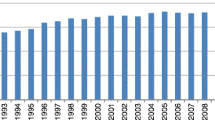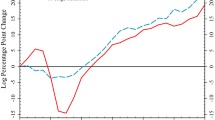Abstract
Previous research has suggested that the smallest firms are those most vulnerable to international competition, as measured by exchange rate fluctuations and import shares. However, that work—and the overwhelming bulk of the empirical literature on determinants of exit or firm survival—dealt entirely with the manufacturing sector of the economy. This paper analyzes annual US data for 1989–2005 for about 50 wholesale and retail sectors to explain small firm exit rates in several employment size categories. The main result is that wholesalers respond negatively to a stronger currency in a manner similar to that of manufacturers, while retailers are generally unaffected.
Similar content being viewed by others
Notes
Restaurants and bars were included as “retail” in the SIC system, but as “services” in the NAICS system. This sector is included in the analysis below. One would expect, however, that firm survival in these sectors will be less closely related to fluctuations in exchange rates than would be the case in sectors involving the sale of goods (some of which may be imported).
Audretsch et al. (1999) also find the dynamic patterns of post-entry growth and survival in services differ from those in the manufacturing sector.
Similarly, Holmberg and Morgan (2003) caution against oversimplifying the issue as one of “survival” versus “failure.”
I have dropped the retail category of “department stores” which had small numbers of establishments under 500 employees, especially in the two smallest size categories, and numbers wildly fluctuating in the SUSB data from year to year (e.g., for 1996, 1997, and 1998, the data reports 1, 52, then 6 firms for establishments under 20 employees).
One data issue that needs to be mentioned is the change in NAICS codes effective with the 2003–2004 exit data; in particular a new category was created of wholesale trade agents and brokers (4251). These firms do not take title to the goods they sell, as opposed to other wholesalers (now referred to as “merchant wholesalers”). This means that the data on numbers of establishments and establishment deaths by wholesale industry sector is not consistent over the entire period (1999–2005) of the NAICS-based sample; it is hoped that this will not bias the time series of exit rates and we will discuss this issue later in the estimation discussion.
Given that definitions are somewhat different in the SIC and NAICS samples, results are presented separately for the two samples.
As noted earlier, establishment exit in the 100–499 size category is overwhelmingly restructuring rather than firm exit.
The wholesale categories are quite broad. Consider some examples: category 4211 includes motor vehicles, but also tires and tubes, parts and supplies (car batteries, axles, auto glass); 4212 includes furniture, but also home furnishings ranging from carpeting and curtains to cookware and utensils, napkins, towels, china and flatware; 4213 includes wood construction materials, and wood cabinets, but also construction materials of brick, stone, metal, glass, roofing materials; 4214 includes film, television cameras, projectors, ATM machines, calculators, safes, computers and printers, computer software, eyeglasses, contact lenses, medical equipment, surveying equipment, restaurant and other commercial equipment. It is not possible to get meaningful import shares averaged over these disparate groups.
This is likely due to the fact that there are very few observations with exit rates at either extreme (i.e., at either zero or one hundred).
In an alternative specification, allowing the impact of GDP growth to vary across industries, the other results of interest were largely unaffected.
A much smaller—though statistically significant—adverse effect is found for the 1–9 employee firms.
As noted earlier, the 2004 and 2005 wholesale sector definitions were changed to exclude “wholesale trade agents and brokers”; inclusion of a dummy variable to distinguish these 2 years and an interaction term between this dummy variable and the exchange rate variable had little impact on results of interest. An alternative approach, dropping these last 2 years from the analysis also produced little change from what is reported in Table 4; the only one of interest is that the very small but statistically significant adverse exchange rate impact on the smallest wholesalers is no longer statistically significant from zero.
However, in results not presented here, there was no statistically significant difference in exchange rate responses for durable versus nondurable goods wholesalers, except in the over-100-employee firms for which nondurable goods wholesalers seemed more adversely affected by exchange rate pressures.
Results for the main variables of interest (especially the exchange rate) are generally unaffected by the inclusion of the number of establishments in the regression equation. This holds true for the retail regressions discussed below, as well.
The fact that this seems to be less of an issue (in this sample only for the very smallest dealers) in the 1999–2005 period may be attributed to a more recent trend of multiple car-line dealers who should be less affected by currency fluctuations, as well as to the increasing tendency of domestic auto manufacturers to produce cars abroad.
References
Audretsch, D. B. (1994). Business survival and the decision to exit. International Journal of the Economics of Business, 1(1), 125–137.
Audretsch, D. B., Klomp, L., & Thurik, R. (1999). Do services differ from manufacturing? The post-entry performance of firms in Dutch services. In Audretsch, D. B. & Thurik, R. (Eds.), Innovation, industry evolution, and employment. Cambridge: Cambridge University Press.
Audretsch, D. B., & Mahmood, T. (1995). New firm survival: New results using a hazard function. Review of Economics and Statistics, 77(1), 97–103.
De Backer, K., & Sleuwaegen, L. (2003). Does foreign direct investment crowd out domestic entrepreneurship. Review of Industrial Organization, 22(1), 67–84.
Dunne, T., Roberts, M., & Samuelson, L. (1988). Patterns of firm entry and exit in US manufacturing industries. RAND Journal of Economics, 19(4), 495–515.
Eckert, A., & West, D. (2008). Firm survival and chain growth in a privatized retail liquor store industry. Review of Industrial Organization, 32(1), 1–18.
Feinberg, R. M. (2008). The impact of international competition on small-firm exit in US manufacturing. US Small Business Administration, Office of Advocacy Report, March.
Fryges, H. (2009). Internationalisation of technology-oriented firms in Germany and the UK. Small Business Economics, 33(2), 165–187.
Geroski, P. (1995). What do we know about entry? International Journal of Industrial Organization, 13(4), 63–88.
Headd, B. (2003). Redefining business success: Distinguishing between closure and failure. Small Business Economics, 21(1), 51–61.
Holmberg, S. R., & Morgan, K. B. (2003). Franchise turnover and failure: New research and perspectives. Journal of Business Venturing, 18(3), 403–418.
Pakes, A., & Ericson, R. (1998). Empirical implications of alternative models of firm dynamics. Journal of Economic Theory, 18(3), 1–45.
Petrunia, R. (2007). Persistence of initial debt in the long-term employment dynamics of new firms. Canadian Journal of Economics, 40(3), 861–880.
Phillips, B. D., & Kirchhoff, B. A. (1989). Formation, growth and survival: Small firm dynamics in the US economy. Small Business Economics, 1(1), 65–74.
Shapiro, D., & Khemani, R. S. (1987). The determinants of entry and exit reconsidered. International Journal of Industrial Organization, 5(1), 15–26.
Siegfried, J. J., & Evans, L. B. (1994). Empirical studies of entry and exit: A survey of the evidence. Review of Industrial Organization, 9(2), 121–155.
Wagner, J. (1994). The post-entry performance of new small firms in German manufacturing industries. Journal of Industrial Economics, 42(2), 141–154.
Acknowledgments
The author is grateful for financial support from the US Small Business Administration under Contract # SBAHQ08M0246, and to Brian Headd for helpful comments and suggestions. Views expressed are his alone, and are not those of the US Small Business Administration.
Author information
Authors and Affiliations
Corresponding author
About this article
Cite this article
Feinberg, R.M. Do international shocks affect small wholesalers and retailers?. Rev World Econ 146, 323–338 (2010). https://doi.org/10.1007/s10290-010-0052-z
Published:
Issue Date:
DOI: https://doi.org/10.1007/s10290-010-0052-z




